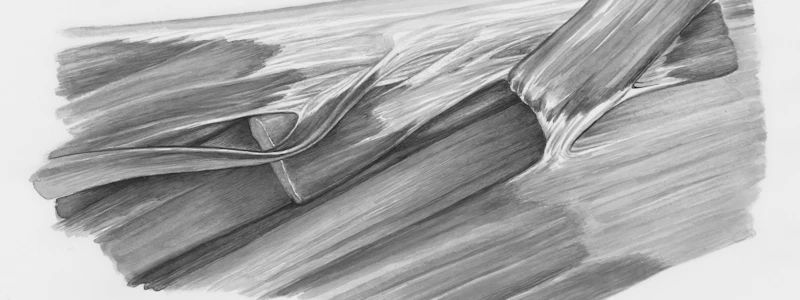Podcast
Questions and Answers
Which type of muscle fibers are primarily used for endurance activities?
Which type of muscle fibers are primarily used for endurance activities?
- Mixed Fibers (Type III)
- Slow-Twitch Fibers (Type I) (correct)
- Fast Twitch Fibers (Type I)
- Fast-Twitch Fibers (Type II)
Fast-Twitch Fibers are fatigue-resistant and used for low-force activities.
Fast-Twitch Fibers are fatigue-resistant and used for low-force activities.
False (B)
What is muscle hypertrophy?
What is muscle hypertrophy?
The increase in muscle size due to resistance training.
During __________ contraction, the muscle shortens while generating force.
During __________ contraction, the muscle shortens while generating force.
Match the type of muscle action with its definition:
Match the type of muscle action with its definition:
What principle suggests that muscles must be progressively overloaded to improve strength or endurance?
What principle suggests that muscles must be progressively overloaded to improve strength or endurance?
Recovery is important for muscle repair and performance improvement.
Recovery is important for muscle repair and performance improvement.
List the three types of muscle and their main characteristics.
List the three types of muscle and their main characteristics.
Which type of muscle tissue is responsible for pumping blood through the heart?
Which type of muscle tissue is responsible for pumping blood through the heart?
Skeletal muscle is involuntary controlled.
Skeletal muscle is involuntary controlled.
What is the function of the rectus abdominis muscle?
What is the function of the rectus abdominis muscle?
The _______ muscle is located in the shoulder and helps lift your arm out to the side.
The _______ muscle is located in the shoulder and helps lift your arm out to the side.
Which muscles are involved in straightening the elbow?
Which muscles are involved in straightening the elbow?
Match the following muscles with their primary functions:
Match the following muscles with their primary functions:
Smooth muscle is found only in the arms and legs.
Smooth muscle is found only in the arms and legs.
Where is the trapezius muscle located?
Where is the trapezius muscle located?
Flashcards
Skeletal Muscle
Skeletal Muscle
Muscle tissue responsible for voluntary movement of bones, attached to bones throughout the body.
Cardiac Muscle
Cardiac Muscle
Muscle tissue found only in the heart, responsible for involuntary pumping of blood.
Smooth Muscle
Smooth Muscle
Muscle tissue responsible for involuntary movement of internal organs, like digestion and blood flow.
Deltoid
Deltoid
Signup and view all the flashcards
Biceps Brachii
Biceps Brachii
Signup and view all the flashcards
Triceps Brachii
Triceps Brachii
Signup and view all the flashcards
Pectoralis Major
Pectoralis Major
Signup and view all the flashcards
Latissimus Dorsi
Latissimus Dorsi
Signup and view all the flashcards
Slow-Twitch Fibers (Type I)
Slow-Twitch Fibers (Type I)
Signup and view all the flashcards
Fast-Twitch Fibers (Type II)
Fast-Twitch Fibers (Type II)
Signup and view all the flashcards
Muscle Contraction
Muscle Contraction
Signup and view all the flashcards
Muscle Hypertrophy
Muscle Hypertrophy
Signup and view all the flashcards
Concentric Contraction
Concentric Contraction
Signup and view all the flashcards
Eccentric Contraction
Eccentric Contraction
Signup and view all the flashcards
Isometric Contraction
Isometric Contraction
Signup and view all the flashcards
Overload Principle
Overload Principle
Signup and view all the flashcards
Study Notes
Muscle Types
- Three main types of muscle tissue: skeletal, cardiac, and smooth
- Skeletal Muscle:
- Structure: Voluntary, striated fibers
- Function: Movement of bones
- Control: Voluntary (conscious control)
- Location: Attached to bones
- Examples: Biceps, triceps, quadriceps
- Cardiac Muscle:
- Structure: Involuntary, striated fibers
- Function: Pumps blood
- Control: Involuntary (heart's pacemaker)
- Location: Heart only
- Examples: Myocardium (heart muscle)
- Smooth Muscle:
- Structure: Involuntary, non-striated fibers
- Function: Internal organ movements (e.g., digestion, blood flow)
- Control: Involuntary
- Location: Walls of hollow organs (stomach, intestines, blood vessels)
- Examples: Muscles of digestive tract, bladder, blood vessels
Key Muscles
- Deltoid: Shoulder; lifts arm
- Biceps Brachii: Upper arm front; bends elbow, turns palm up
- Triceps Brachii: Upper arm back; straightens elbow
- Pectoralis Major: Chest; brings arm in, moves arm forward
- Latissimus Dorsi: Lower back; pulls arms down and back
- Trapezius: Upper back and neck; moves neck and shoulders, lifts shoulder blades
- Rectus Abdominis: Abdomen; bends forward
- Obliques (External & Internal): Sides of abdomen; twists body, bends sideways
- Gluteus Maximus: Buttocks; moves hip back and out
- Quadriceps: Front thigh; straightens knee, bends hip
- Hamstrings: Back thigh; bends knee, moves hip back
Muscular System
- Muscle Fibers:
- Slow-Twitch (Type I): Endurance activities (low force, fatigue-resistant)
- Fast-Twitch (Type II): Explosive activities (high force, fatigue quickly)
- Muscle Contraction Process:
- Action Potential: Electrical impulse travels through nerves
- Neuromuscular Junction: Acetylcholine release stimulates muscle
- Sliding Filament Theory: Actin and myosin filaments slide
- Muscle Hypertrophy: Increased muscle size due to resistance training (strength increase)
Muscle Actions
- Concentric Contraction: Muscle shortens while generating force (e.g., lifting a weight)
- Eccentric Contraction: Muscle lengthens while generating force (e.g., lowering a weight)
- Isometric Contraction: Muscle generates force without changing length (e.g., holding a plank)
Trained Muscles and Performance
- Adaptations to Training: Increased muscle mass (hypertrophy), improved neuromuscular efficiency (strength training), increased mitochondrial density, enhanced oxygen delivery (endurance training)
- Overload Principle: Progressively increase training load for improvement
- Specificity Principle: Training adapts to the type of activity
- Recovery: Essential for muscle repair
Test Preparation
- Understand the three muscle types and their characteristics
- Know 11 key muscles and their functions
- Master the mechanics of muscle contraction
- Relate muscle fiber types to performance
- Learn training adaptations and principles
- Recognize the importance of recovery
Studying That Suits You
Use AI to generate personalized quizzes and flashcards to suit your learning preferences.




